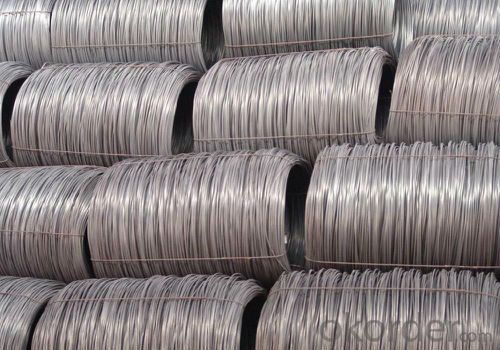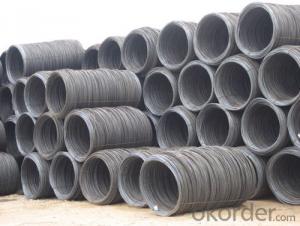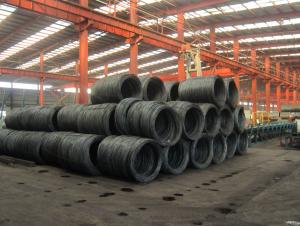High Quality Steel Wire Rod SAE1008 8.0mm
- Loading Port:
- Tianjin
- Payment Terms:
- TT or LC
- Min Order Qty:
- 50 m.t
- Supply Capability:
- 10000 m.t/month
OKorder Service Pledge
OKorder Financial Service
You Might Also Like
High Quality Steel Wire Rod SAE1008 8.0mm
Product Description:
Specifications of Wire Rod SAE1008:
Grade: SAE1008 Standard: ASTM
Diameter: 8.0mm
Alloy or Not: Alloy
Technique: Hot Rolled Place of Origin: China Mainland
Chemical Composition:
Please kindly find our chemistry of our material based on SAE1008 as below for your reference:
Grade | Chemical Composition (%) | |||||
C | Mn | S | P | Si | ||
SAE1008 | 0.10max | 0.32max | 0.045max | 0.040max | 0.30max | |
Mechanical properties | ||||||
Yield strength(N/mm2) | Tensile strength(N/mm2) | Elongation (%) | ||||
≥195 | 350-380 | ≥32 | ||||
Usage and Applications of High Quality Steel Wire Rod SAE1008 8.0mm:
After hot-rolled the products shaped into coil and delivery as finished product, including round, square,rectangular, hexagonal and so on. Since most of the products are round, it is generally called wire rod. Carbon steel wire rod is widely used in construction and manufacturing. Carbon steel wire rod is mainly used for reinforcement of reinforced concrete and welded structure or reprocessed (roberts , nail, etc.) materials, especially used to produce wire drawing, welding electrode, nails, spring, electronic, precise machinery parts and so on.
Packaging & Delivery of High Quality Steel Wire Rod SAE1008 8.0mm:
Packaging Detail: products are packed in coil and then shipped by container or bulk vessel
Each coil weight: About 2.05MT
Delivery Detail: within 45 days after received deposit or LC.
Label: to be specified by customer, generally, each bundle has 1-2 labels
Trade terms: FOB, CFR, CIF
FAQ:
Q1: Why buy Materials & Equipment from OKorder.com?
A1: All products offered byOKorder.com are carefully selected from China's most reliable manufacturing enterprises. Through its ISO certifications, OKorder.com adheres to the highest standards and a commitment to supply chain safety and customer satisfaction.
Q2: How do we guarantee the quality of our products?
A2: We have established an advanced quality management system which conducts strict quality tests at every step, from raw materials to the final product. At the same time, we provide extensive follow-up service assurances as required.
Q3: How soon can we receive the product after purchase?
A3: Within three days of placing an order, we will arrange production. The shipping date is dependent upon the quatity, how many sizes you want and the plan of production, but is typically 1 month to 2 month days from the beginning of production.
Images of High Quality Steel Wire Rod SAE1008 8.0mm:


*If you would like to get our price, please inform us the size, standard/material and quantity. Thank you very much for your attention.
- Q:Can steel wire rod be recycled?
- Certainly, the recycling of steel wire rod is possible. Steel, being a material highly amenable to recycling, can undergo a rather uncomplicated recycling procedure when it comes to steel wire rod. Generally, the recycling process entails the gathering of discarded steel wire rod, its subsequent separation from any impurities, and finally, its melting to be reshaped into fresh steel goods. Recycling steel wire rod aids in the preservation of natural resources, diminishes the necessity for mining and producing novel steel, and additionally, yields environmental advantages by curbing greenhouse gas emissions and lowering energy consumption linked to the manufacture of new steel.
- Q:How is steel wire rod used in the manufacturing of wire mesh sieves?
- Steel wire rod is used in the manufacturing of wire mesh sieves as it serves as the raw material for forming the wire mesh. The steel wire rod is first drawn or stretched to the desired thickness and then woven or welded together to create the mesh pattern. This process ensures the strength, durability, and uniformity of the wire mesh sieves, making them suitable for a wide range of applications such as filtration, grading, and particle size analysis.
- Q:What are the common types of internal defects in steel wire rod?
- Some common types of internal defects in steel wire rod include inclusions, segregations, cracks, and voids. Inclusions are foreign substances that are trapped within the steel during the manufacturing process. Segregations occur when the composition of the steel is not uniform, resulting in areas with different properties. Cracks can occur due to excessive stress or improper cooling during production. Voids are empty spaces or cavities within the steel. These defects can weaken the wire rod and affect its overall quality and performance.
- Q:What are the common industry competencies for steel wire rod manufacturers?
- The common industry competencies for steel wire rod manufacturers include expertise in metallurgy, production processes, quality control, and product development. They should have a deep understanding of steel properties, heat treatment, and alloying techniques to ensure the desired mechanical properties of the wire rod. Additionally, they should possess advanced manufacturing capabilities, such as wire drawing, rolling, and finishing, to produce wire rod with precise dimensions and surface quality. Quality control measures, including testing and inspection, are crucial to ensure compliance with industry standards and customer requirements. Lastly, continuous product development and innovation are essential to meet evolving market demands and stay competitive in the industry.
- Q:What are the different types of steel wire rod surface defects and their detection methods?
- There are various types of steel wire rod surface defects that can occur during the manufacturing process. These defects can significantly affect the quality and integrity of the wire rod, making it essential to detect and address them before they cause any further issues. Here are some common types of steel wire rod surface defects and their detection methods: 1. Scale: Scale refers to the presence of oxide layers on the surface of the wire rod. It can occur due to exposure to high temperatures during production. Scale can be detected visually by examining the wire rod's surface for discoloration or by performing a simple scratch test to check if the scale flakes off easily. 2. Cracks: Cracks in the surface of the wire rod can be caused by various factors such as improper cooling, excessive stress, or material defects. Visual inspection is the most common detection method, where the wire rod is examined for visible cracks or fracture lines. Additionally, non-destructive testing techniques like magnetic particle inspection or ultrasonic testing can be employed for more accurate and reliable crack detection. 3. Pitting: Pitting is the formation of small depressions or cavities on the wire rod's surface due to corrosion or mechanical damage. Visual inspection is usually sufficient to detect pitting, as it appears as small, localized areas with irregular surfaces or indentations. However, if pitting is not easily visible, techniques like dye penetrant inspection or eddy current testing can be used for a more detailed examination. 4. Surface roughness: Surface roughness refers to an uneven or irregular texture on the wire rod's surface. It can occur due to improper manufacturing processes or inadequate quality control. Visual inspection can detect surface roughness by examining the wire rod for inconsistencies in the smoothness or by using a profilometer to measure the roughness quantitatively. 5. Inclusions: Inclusions are non-metallic substances (e.g., slag, dirt, or oxide particles) embedded in the wire rod's surface. They can cause weak spots or affect the wire rod's mechanical properties. Visual inspection can detect large inclusions, while microscopic examination or techniques like X-ray inspection can identify smaller or subsurface inclusions. 6. Coating defects: If the wire rod has a coating, defects like peeling, blistering, or uneven thickness can occur. Visual inspection is generally sufficient to detect these defects, but additional techniques like ultrasonic testing or electrical conductivity measurements can be employed for a more comprehensive assessment. It is important to note that while visual inspection is commonly used, more advanced techniques like non-destructive testing (NDT) methods can provide more accurate and reliable detection of surface defects. Employing a combination of these methods can ensure the identification and rectification of any surface defects in steel wire rods, ultimately enhancing their quality and performance.
- Q:What are the common applications of carbon steel wire rod?
- Carbon steel wire rod is widely used in various industries due to its excellent mechanical properties and versatility. Here are some common applications of carbon steel wire rod: 1. Construction: Carbon steel wire rod is extensively used in the construction industry for reinforcing concrete structures. It is commonly used to make wire mesh, reinforcement bars, and pre-stressed concrete products. 2. Automotive: Carbon steel wire rod is used in the automotive industry for manufacturing springs, suspension components, and wire harnesses. Its high strength and flexibility make it suitable for these applications, ensuring reliable performance and durability. 3. Manufacturing: Carbon steel wire rod is utilized in various manufacturing processes, including wire drawing, cold heading, and cold forging. It is commonly used to produce fasteners, bolts, nuts, and other small metal components. 4. Agriculture: Carbon steel wire rod is widely used in the agricultural sector for applications such as fencing, vineyard trellising, and animal enclosures. It offers high tensile strength and resistance to corrosion, making it ideal for outdoor environments. 5. Wire Products: Carbon steel wire rod is the primary raw material for producing a wide range of wire products, such as cables, wire ropes, and galvanized wires. These products find applications in industries such as telecommunications, construction, and manufacturing. 6. Energy and Power: Carbon steel wire rod is used in the energy and power sector for manufacturing electrical transmission and distribution lines. It provides the necessary strength and conductivity required for efficient power transmission. 7. Furniture and Household Goods: Carbon steel wire rod is used in the production of furniture, kitchenware, and other household goods. It can be formed into different shapes, providing structural support and durability to these products. In summary, carbon steel wire rod finds a wide range of applications in construction, automotive, manufacturing, agriculture, wire products, energy and power, as well as furniture and household goods industries. Its mechanical properties, versatility, and cost-effectiveness make it a popular choice for various applications.
- Q:What are the main factors affecting the market advocacy of steel wire rod?
- The main factors affecting the market advocacy of steel wire rod include the demand and consumption patterns in various industries such as construction, automotive, and manufacturing. Economic conditions, including GDP growth and infrastructure development, also play a significant role. Additionally, fluctuations in steel prices, availability of raw materials, technological advancements, and government regulations related to trade policies and environmental sustainability impact the market advocacy of steel wire rod.
- Q:How does the corrosion resistance of steel wire rod vary with different surface treatments?
- Different surface treatments can greatly affect the corrosion resistance of steel wire rod. These treatments are used to improve the wire rod's ability to withstand corrosion and extend its lifespan. One common treatment for steel wire rod is galvanization, which involves applying a layer of zinc to the surface. This zinc coating acts as a sacrificial barrier, protecting the steel underneath from corrosion. Galvanized steel wire rod offers excellent corrosion resistance and can endure harsh conditions like high humidity or corrosive chemicals. Phosphating is another treatment option for steel wire rod. It entails applying a phosphate coating to the surface, enhancing its resistance to corrosion. This coating forms a protective layer, preventing rust formation and halting the spread of corrosion. Furthermore, steel wire rod can be coated with various substances, such as epoxy or polymers, to provide an additional layer of defense against corrosion. These coatings act as barriers, preventing moisture and corrosive substances from reaching the steel surface. Coated steel wire rod exhibits improved corrosion resistance and can be used in environments where direct exposure to moisture or corrosive agents is expected. It is important to note that the effectiveness of surface treatments in enhancing corrosion resistance can vary depending on specific conditions and the quality of the treatment. Factors like coating thickness and adhesion, presence of defects or impurities, and the type and concentration of corrosive substances in the environment can all impact the corrosion resistance of steel wire rod. In conclusion, the corrosion resistance of steel wire rod can be significantly improved through surface treatments like galvanization, phosphating, or the application of coatings. These treatments create protective barriers that ensure the wire rod's longevity and durability in different environments.
- Q:How are steel wire rods used in the manufacturing of piano strings for musical instruments?
- Steel wire rods are an essential component in the manufacturing of piano strings for musical instruments. These wire rods are typically made of high-quality steel that is carefully engineered to provide the desired properties for piano strings. The first step in utilizing steel wire rods is to draw them through a series of dies to reduce their diameter and increase their tensile strength. This process, known as wire drawing, ensures that the steel wire rods are strong enough to withstand the tension required for piano strings. Once the steel wire rods have been drawn to the desired size, they are further processed to form the individual piano strings. The wire is cut into specific lengths and then coiled to create the desired shape and size for each string. These coils are then wound around a core wire, which provides stability and enhances the tonal quality of the string. The use of steel wire rods in piano string manufacturing is crucial for several reasons. Firstly, steel is known for its durability and resistance to stretching, making it ideal for withstanding the constant tension and pressure exerted on piano strings. Additionally, steel wire rods have excellent flexibility, allowing the strings to vibrate freely and produce a rich, resonant sound. Moreover, the precise manufacturing process of steel wire rods ensures that the resulting piano strings have consistent quality and uniformity. This is crucial for maintaining the integrity and balance of sound across the entire piano keyboard. In conclusion, steel wire rods play a vital role in the manufacturing of piano strings. Their strength, flexibility, and precision make them an ideal material for producing high-quality strings that can withstand the demanding requirements of a piano.
- Q:How is steel wire rod tested for dimensional accuracy?
- Steel wire rod is tested for dimensional accuracy through a process called diameter measurement. This involves using calibrated measuring instruments, such as micrometers or laser sensors, to precisely measure the diameter of the wire rod at different points along its length. These measurements are then compared to the specified tolerances and standards to ensure that the wire rod meets the required dimensional accuracy.
1. Manufacturer Overview |
|
|---|---|
| Location | |
| Year Established | |
| Annual Output Value | |
| Main Markets | |
| Company Certifications | |
2. Manufacturer Certificates |
|
|---|---|
| a) Certification Name | |
| Range | |
| Reference | |
| Validity Period | |
3. Manufacturer Capability |
|
|---|---|
| a)Trade Capacity | |
| Nearest Port | |
| Export Percentage | |
| No.of Employees in Trade Department | |
| Language Spoken: | |
| b)Factory Information | |
| Factory Size: | |
| No. of Production Lines | |
| Contract Manufacturing | |
| Product Price Range | |
Send your message to us
High Quality Steel Wire Rod SAE1008 8.0mm
- Loading Port:
- Tianjin
- Payment Terms:
- TT or LC
- Min Order Qty:
- 50 m.t
- Supply Capability:
- 10000 m.t/month
OKorder Service Pledge
OKorder Financial Service
Similar products
New products
Hot products
Related keywords




























